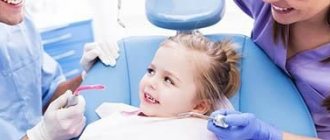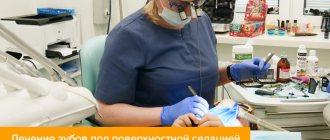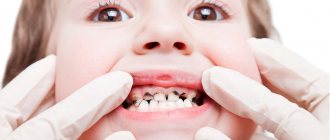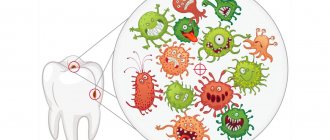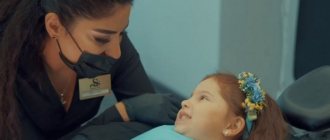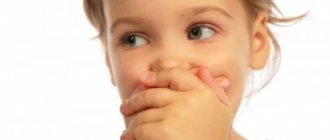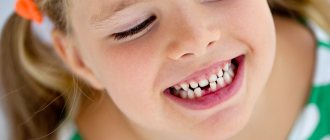- Why is it important to care for baby teeth?
- Which toothpaste to choose for a child
- How to choose a toothbrush for a child
- How to choose an electric brush for a child
- How to reduce the risk of developing caries and not give up sweets
- How to teach a child to brush their teeth
- Tips from a pediatric dentist: video
The age group from 3 to 8 years is characterized by the primary dentition, as well as the beginning of the mixed dentition - the appearance of the first permanent teeth. A child at this age learns to brush his teeth and can use an electric brush independently.
Today we will look at what oral care products you need to have at home for children of this age group. You will learn how to help a child with the habit of brushing their teeth daily, what to use to form healthy permanent teeth, and how to reduce the risk of developing caries without giving up sweets.
Why is it important to care for baby teeth?
There is a common misconception that caring for baby teeth is not necessary. After all, these teeth are not forever, and new “real” ones will soon grow to replace them. But in fact, you should start taking care of the health of permanent teeth long before they appear.
The health of future molars directly depends on the condition of the milk teeth, because their rudiments do not appear out of nowhere - they are already located under the milk teeth.
Temporary teeth influence the formation of the correct bite of permanent teeth. For example, if a baby tooth becomes inflamed, it may be delayed in falling out and spoil the growth of the permanent tooth, and if it is pulled out prematurely, the permanent tooth may grow crooked.
In addition, the early habit of caring for teeth, when they are still baby teeth, will ensure the child’s health for many years.
“Why treat baby teeth if they fall out?” 33 unobvious facts about children's teeth
At what age should a child be taught to brush their teeth? How to do this correctly: do you need a special brush, paste, gadgets? “Mel” and Colgate asked these and other questions to Ani Safaryan, a dental therapist, a doctor at a children’s aesthetic dentistry clinic, and a member of the International Association of Pediatric Dentistry, and compiled the ultimate guide to children’s teeth.
Useful Mela newsletter twice a week: Tuesday and Friday
SUBSCRIBE
1. Even baby teeth need to be brushed.
It is especially important to do this if the child is bottle-fed or if his diet contains fruits, juices, dairy products and sugar: all of this increases the risk of caries. For the very first teeth, a silicone finger brush is suitable. It should, of course, not be used by the child, but by the parents - just gently brush the baby’s teeth in the morning, in the evening and (optionally) after meals.
2. Toothpastes can be used even for children under one year old.
When the first teeth are just emerging, you can brush them without toothpaste, and then gradually accustom your child to using it (for the little ones, choose soft options without fluoride, such as Colgate 0-2 “Tender Fruit”). Such a ritual will not only be a good prevention of caries, but will also help form a healthy habit.
3. It is important to brush your teeth with vertical rather than horizontal movements.
You can use this video for inspiration. Or use a universal technique - sweeping vertical movements from the edge of the gum to the edge of the tooth. Be sure to brush your teeth both inside and outside. Don't forget about the chewing surface. It is important to pay special attention, especially to children, to the cervical areas of the teeth - those located next to the gums. Bacteria tend to accumulate in these areas, which can cause your gums to bleed.
4. A child’s teeth need to be brushed before the age of 7 years.
The motor skills of preschoolers' hands are not yet sufficiently developed; it is difficult for them to reach all areas of the teeth and clean them thoroughly, so parents' help is necessary here.
5. You can learn to brush your teeth in a playful way.
For example, take toys that have teeth and show them with what movements they need to be cleaned. A child who is interested in science (and this is almost all preschoolers) can be told about bacteria and how he can defeat them with the help of toothpaste and a toothbrush.
6. Bacteria are the main cause of tooth decay.
Of course, the presence of a large amount of sweets in the diet, hygiene, constant snacking, concomitant diseases and genetics also play a significant role. And yet, according to research, the bacterial factor is the determining factor. Those “holes” in the teeth are caused by species of streptococcus that feed on sucrose and destroy the enamel. The main way to combat them is regular oral hygiene: it is important to teach your child to brush their teeth every morning and evening as early as possible.
7. The gold standard for brushing your teeth is 2-3 minutes.
This is exactly the recommendation most dentists give (and some insist on 4 minutes). The fact is that two types of plaque form on the teeth - soft and hard. The first one can be removed quite quickly, but to eliminate the second one just needs at least two minutes. Plus, if the toothpaste contains active substances, then in order for them to act externally, the paste should also be used for at least two minutes.
8. You need to brush your teeth at least twice a day: after breakfast (or about an hour before it) and after dinner.
Brushing your teeth after every meal is ideal, but simply rinsing your mouth with water also works well in these cases. To help make brushing a healthy habit, every bottle of Colgate Children's Toothpaste includes a colorful brochure with a brushing calendar, parenting tips, and fun baby resources.
9. One of the mistakes when brushing your teeth is putting too much pressure on the brush.
There is no need to do this; in 2–3 minutes you can thoroughly clean your teeth with soft sweeping movements. Rubbing too vigorously can have a negative impact on the enamel. To check how much pressure you actually need to apply to the brush, you can brush your teeth with your opposite hand. This will be the ideal load level.
10. Age is an important marker when choosing toothpaste for children.
For example, toothpastes for small children do not contain fluoride, which means they will not harm the child if swallowed. In the Colgate children's line, these are pastes 0-2 Colgate “Tender Fruit” and Colgate 3-5 “Tender Mint”, intended for the care of baby teeth. Pastes for older children, as a rule, contain fluoride: at this age, children already know how to brush their teeth and do not often swallow toothpaste. Fluoride, when applied externally, has a proven anti-carious effect. Colgate's children's toothpastes with fluoride include Colgate 3-5 Strawberry Children's Toothpaste and Colgate 6-9 Strawberry-Mint Children's Toothpaste.
11. Don't be afraid of fluoride.
Fluoride (the fluoride salt found in toothpastes) is not hazardous to health; on the contrary, it has a proven anti-caries effect. Topical fluoride treatments (fluoridation in the doctor's office or similar applications at home), as well as the use of fluoride toothpaste (as long as the child does not swallow it regularly) help strengthen tooth enamel and are often prescribed by dentists as a cavity prevention therapy.
12. A toothbrush should have artificial, not natural, bristles.
Natural bristles, unlike man-made nylon or polyester, absorb moisture, which can lead to bacterial growth. Also, when choosing a brush, we look at the age marking and degree of hardness - brushes for children under 5 years old should be very soft (sensitive, ultrasoft, extrasoft), for children from 5 to 12 years old - just soft (soft). Don’t forget to change your toothbrush at least once every 3 months (and every time after an illness).
13. There is no need to squeeze out the paste in waves, as they do in advertising.
A small pea amount will be enough for daily brushing of teeth. Due to the foaming substances included in the toothpaste, this amount works great - this will be enough to cleanse the oral cavity.
14. It is not necessary to rinse your mouth with water after brushing your teeth.
If the paste contains hydroxyapatites and minerals, you can leave it on the teeth even overnight: this way we provide additional remineralization of the teeth.
15. Mouthwash is not a substitute for brushing your teeth.
But it won't do any harm either. If your child is away from home and does not have the opportunity to brush their teeth, mouth rinses will help get rid of food residues after eating.
16. Brushing your teeth at night is very important.
During the day we eat and talk, due to which partial self-cleaning of the teeth occurs. At night, we do not make active muscle movements, therefore, plaque accumulates, bacteria continue to multiply, and this can lead to caries.
17. The tongue also needs to be cleaned: bacteria also accumulate on its surface.
There are special scrapers and attachments for the irrigator for this. In addition, on the back surface of regular children's toothbrushes there is a special pad for cleaning the tongue - it is also important to get into the habit of using it. You need to clean your tongue from root to tip; five movements are usually enough for effective cleansing.
18. One year is the optimal age for your first visit to the dentist.
Children at this age are already starting to teethe, and the doctor can assess whether everything is going well. Plus, one-year-old babies are still free from the frightening stereotypes associated with visiting the dentist. If you continue to visit the doctor regularly, your child will simply get used to him and will not be afraid.
19. It is recommended to visit the dentist with your child once every three months.
Or once every six months - if the child does not have significant problems and your doctor is not against such an interval. From the age of two, children can undergo professional oral hygiene, but the optimal tactics for your child should be advised by a doctor.
20. If a child complains of tooth pain, you should take him to the dentist as soon as possible.
In children, all processes (from enamel destruction to inflammation) pass faster, and a situation where a tooth can be cured can quite quickly become a case in which it can no longer be saved.
21. Even baby teeth sometimes need to be removed.
This can happen with some complicated inflammatory processes, severe damage to the enamel or with injuries. But caries, pulpitis and non-chronic damage to the enamel, as a rule, can be cured - it is important to see a dentist as soon as possible, and not let the process take its course, believing that baby teeth will fall out anyway and you don’t mind them.
22. It happens that baby teeth fall out, but the molars do not grow.
One of the reasons for this phenomenon is genetic pathology, adentia. But it also happens that the baby teeth are so badly damaged that the rudiments of the molars die because of this. That is why caries on baby teeth is also very important to treat, and they need to be cared for in the same way as molars.
23. If a child constantly breathes through his mouth, he should be taken not only to a pediatrician and ENT specialist, but also to a dentist.
Mouth breathing (which can be caused by ENT pathologies) can provoke the development of malocclusion, especially when it comes to preschoolers. When a small child constantly breathes through his mouth, changes gradually appear in his dental system, a certain type of swallowing and breathing is formed - all this can affect not only his appearance (bad bite, changes in the oval of the face), but also the quality of life. The problem needs to be resolved with an ENT specialist, a dentist, and often with the involvement of an orthodontist and speech therapist.
24. Posture and bite are connected.
The temporomandibular joint is also part of the musculoskeletal system, and, for example, the curvature of the spine can affect its formation. Plus, the bite can also be affected by improper load on the cervical spine and other disorders in the development of the musculoskeletal system. Therefore, ideally, not only an orthodontist, but also an orthopedic doctor should work on bite correction.
25. The child must eat solid food
- for example, carrots or apples. This is necessary not only for cleaning the teeth, but also for the development of the jaw muscles: when formed correctly, they also help the digestive system function and also ensure proper bite.
26. Chewing gum can be helpful.
This is gymnastics for muscles and additional cleansing. But chewing them for more than ten minutes is harmful to the gastrointestinal tract.
And you definitely shouldn’t think that chewing gum can replace brushing your teeth.
It is important to choose sugar-free gums and not give them to small children who may swallow them.
27. Toothpicks do more harm than good.
The problem is that their pointed tips can easily injure the gums. Or a piece of toothpick may get stuck in the interdental space. In addition, the effectiveness of toothpicks is very questionable: they do not penetrate into narrow spaces between teeth, which means their use is pointless. But dental floss is a good alternative.
28. Children do not need to whiten their teeth.
Bleaching is generally not the most beneficial procedure. Whitening products are based on hydrogen peroxide, which is a rather toxic substance. To prevent plaque from forming on children's teeth, you can simply have hygienic cleanings at the dentist - they are usually recommended to be done once every three months (but only your doctor can give an exact prescription).
29. Yellowish enamel is normal.
Molars always have a slightly more yellow tint than baby teeth, and that’s how it should be. You need to worry if one tooth is very different in shade from all the others; this condition is called “discoloration” and is associated with injury or an inflammatory process.
30. Stains on teeth (white, matte, dark) are not a harmless phenomenon.
This is a sign of enamel demineralization, that is, the proliferation of cariogenic bacteria, and indicates a high risk of caries. But this condition is treatable. Typically, the dentist performs deep fluoridation procedures in the office and prescribes supportive ones to be performed at home.
31. Dental floss is an important element of oral hygiene.
It is not necessary to use it until about 2.5 years of age; at this age, teeth, as a rule, have not fully erupted.
It is important to introduce a child to dental floss between the ages of 2.5 and 4 years, especially if there are quite close contacts between the teeth
A toothbrush cannot clean the spaces between them, which means that the risk of contact caries (that is, caries that occurs in places where teeth touch each other) increases. The dentist will show you how to use dental floss correctly and which one is right for your child. A small child should use this thread under parental supervision.
32. Irrigators (or devices for cleaning interdental spaces) are completely safe for children.
Children's teeth often fit quite tightly together, and preschoolers or primary schoolchildren still cannot clean them thoroughly - in this case, an irrigator will help with the hygiene of interdental spaces and will prevent contact caries. But it is important to use this device under parental supervision and at low power, otherwise the risk of injury increases. It is important to understand: the irrigator does not replace a toothbrush, but serves as an addition to it. It is better to use it in the evening, after basic hygiene procedures, for about 3-5 minutes.
33. A plaque indicator will help show your child whether he is brushing his teeth well.
This is a product in tablets or drops that stains the mouth and highlights areas that the child was not able to clean thoroughly. This technique will help teach your child to brush their teeth more carefully and clean them properly even in hard-to-reach places.
To maintain the health of children's teeth, it is important to visit the dentist regularly, teach the child to monitor oral hygiene from a very early age and use high-quality products with active ingredients according to the child's age.
Which toothpaste to choose for a child
The choice of toothpastes for children 3–8 years old is slightly wider than for toddlers - the child has already learned to spit out the toothpaste, so it may contain fluoride.
When choosing a toothpaste with fluoride, look at the safe concentration of this component - this is 500-900 ppm for children from 3 to 8 years old.
In addition to paste, you can use gels that strengthen the enamel. For example, Tooth Mousse - it helps to get rid of increased sensitivity and prevent the development of caries. There is no sugar in it, and the main components of the gel are calcium and phosphates, which are necessary for dental health. Remineralizing gel can be applied after brushing directly to the teeth or in special trays.
What should not be in baby toothpaste?
The fact that a child has already learned not to swallow toothpaste does not mean that he will not do this if the paste is especially tasty. For such cases, manufacturers have excluded harmful substances from the composition and found substitutes for them.
Children's toothpaste should not contain SLS and parabens. If the paste foams, it means it contains SLS, and it is better to discard it.
In addition, for proper care it is important that the baby toothpaste contains a minimum amount of abrasive substances. Soft abrasives are necessary for effectively cleaning teeth from plaque in adulthood, but there should be little of them in the composition of children's toothpaste. On the packaging, the degree of abrasiveness is indicated by the abbreviation RDA and for children ranges from 0 to 50.
What substances are useful in baby toothpastes?
Pay attention to the composition when choosing a new toothpaste for your child. You already know what should not be in the composition. Useful substances include fluorine and hydroxyapatite (or nanohydroxyapatite).
- Fluoride is an important substance for teeth, so toothpaste should contain a small amount of fluoride, which is usually indicated on the package. For children under 4 years old - 200 ppm, from 4 to 8 years old - 500 ppm.
- Hydroxyapatite is a modern alternative to fluorine. Synthetic hydroxyapatite is identical to the natural one that makes up enamel. It easily integrates into its crystal lattice and strengthens it, sealing microcracks and reducing sensitivity. In addition, hydroxyapatite eliminates caries at the white spot stage.
- Flavoring additives. This is not the most important and useful component - its choice depends on the preferences of the child himself. But it is important to know that flavors in children's toothpaste do not have to be of natural origin. Now special synthetic analogues have been developed that are completely safe if swallowed.
Toothpaste Dentissimo Junior Apple (from 6 years old)
Toothpaste ROCS (ROCS) Kids Berry Fantasy (from 4 to 7 years)
Toothpaste Brush-Baby Multifruit (from 3 to 6 years)
Biorepair Kids toothpaste with strawberry flavor (from 0 to 6 years)
What else should you do to keep your child's teeth healthy?
- Limit your consumption of sweets , especially between meals. Caries develops when carbonaceous food residues remain on the teeth, they are processed by oral microorganisms and become acids that destroy the teeth. It should be remembered that caries develops faster the more often and longer refined carbohydrates are in contact with teeth. Give your child sweets only immediately after meals or on a day off, and immediately after that the child should brush his teeth or rinse his mouth. This should also be done after each use of a medication containing sugar (cough syrups, antipyretics, vitamin syrups, etc.).
- Breastfeeding is the best for your baby and his teeth.
- Juices and other sugary drinks should be drunk through a straw .
- Give up the bottle and pacifier in time . If a child drinks sugar-containing substances from a bottle with a nipple (tea, compote, formula, porridge, even breast milk), he should never be allowed to fall asleep with the bottle or hold it in his mouth for a long time - this leads to rapid tooth decay. In foreign dentistry there is even a special term - “bottle caries”, which means damage to teeth due to frequent and prolonged use of a bottle with a pacifier. Accustom your child to using a spoon and a cup in time - before his first birthday, the child should drink only from a cup!
- Maintain hygiene - you should not give your child a pacifier or spoon that you yourself have licked or that you have tried the child’s food with.
- Make sure that your child uses his teeth for their intended purpose - actively chewed, did not be lazy in gnawing hard vegetables and fruits, did not put foreign objects in his mouth, did not suck or bite his tongue, cheeks, lips.
- Dental health is closely related to the overall health of the child . Hardening a child, preventing and treating other diseases is also the prevention of caries.
- Consult with your pediatrician about the advisability of prescribing vitamins and calcium supplements to your child, which are necessary not only for the general strengthening of the body, but also for the proper formation of healthy teeth.
- Regularly carefully examine the child’s teeth : the reason for immediately contacting the dentist is the appearance of stains (white, yellow, black), depressions on the enamel of the teeth, the child’s anxiety when touching the teeth, brushing them, bleeding gums, etc. It should be remembered that the first signs of caries are reversible, they can be cured, and the deeper the damage to the tooth, the more difficult and lengthy the treatment will be. Untreated primary teeth can lead to problems with permanent teeth!
- Visit the dentist regularly - at least 3-4 times a year. Even if the child does not have any problems with teeth, it is necessary to show him to the dentist before his first birthday, and in the future do not forget that the dentist not only treats teeth, but also does everything to ensure that the teeth remain healthy and do not have to be treated !
How to choose a toothbrush for a child
In this age group, both manual and electric brushes can be used. Brushes and attachments should be replaced every 2–3 months, as well as immediately after an acute infectious disease.
When choosing a suitable brush, pay attention to the following criteria.
- Age of the child. This is simple - pay attention to the age marking when choosing. For brushes recommended from 3 to 5 years, the length of the handle does not exceed 15 cm and the length of the head is 2 cm. From 5 to 8 years, the handle is up to 17 cm, the head is 2–2.5 cm.
- The stiffness of the bristles. Soft or ultra-soft bristles are suitable for children.
- Handle - should have anti-slip silicone or rubber inserts. Since fine motor skills are still developing, the brush should be such that the child can confidently hold it in his hands.
- Design. A brush with a bright design or with a favorite character will help get your child interested in brushing their teeth.
Healthy foods
To avoid caries and gum inflammation in your baby, it is important not only to teach him to take vitamins, but also to balance his diet. The most beneficial foods for teeth and gums are:
- Dairy . They contain a significant amount of calcium, maintain healthy enamel, and strengthen teeth.
- Leafy vegetables . During the chewing process, they clean the oral cavity and destroy microorganisms in hard-to-reach areas.
- Water . It is important for children to drink enough fluids per day. A dehydrated body is less resistant to attack by viruses and bacteria.
- Fish. River and sea inhabitants contain selenium, fluorine, phosphorus and calcium, substances essential for the health of gums and teeth.
So, now you know what vitamins are needed to strengthen teeth, gums and the normal development of a child. We are sure that you will be able to create a delicious and healthy menu for your beloved baby and select vitamin complexes suitable for teeth.
And to turn your child’s daily dental care into a holiday, try Asepta Kids toothpaste with a bright “tutti-frutti” flavor. This gel paste was developed taking into account the structure of enamel in children aged 4-8 years, specifically for the daily protection of children's teeth from caries and the prevention of gum inflammation. "Acepta Kids" does not contain fluoride and gently cleans teeth from caries, prevents gum inflammation and the formation of tartar.
How to choose an electric brush for a child
From the age of 3 you can start using an electric brush. The advantage is that in children's lines you can find great opportunities for interactivity.
Some brands produce electric brushes with the ability to control brushing time via an app. The mobile application synchronizes with the brush and uses animated prompts to teach your child how to brush their teeth correctly. This helps maintain interest in the process.
For children aged 3 to 6–7 years, an electric brush with the softest bristles is suitable. It can be alternated with a regular brush. But remember: the use of an electric brush by a preschool child needs to be supervised.
Dental treatment for children: yesterday and today
Just 15-20 years ago, finding a specialized clinic or specialized specialist for a child was quite a difficult task, especially in small provincial towns. Children often had to be treated in government institutions, where sometimes even minimal comfort was not provided, which is why many children subsequently suffered from dental phobia. Today the situation has changed dramatically: many private high-class pediatric or family dentistry clinics have appeared, which provide a decent level of treatment and service. The main problem today remains the rather low information awareness of patients, which is why many children do not receive timely treatment and have all sorts of complications.
For example, many parents seriously believe that it is not necessary to treat baby teeth, because they will fall out in any case, so often the child ends up in the dental chair when it is not possible to save the tooth. Of course, this approach is fundamentally wrong. Under the milk teeth are the rudiments of molar teeth, so early loss of temporary teeth or extensive infections threatens a number of complications: from impaired development of permanent teeth to serious dental anomalies. The summary here is obvious: you need to monitor your dental health and eliminate problems in a timely manner from a very early age. Of course, dental treatment for children of different age groups has its own characteristics, so let’s take a closer look at the specific nuances.
How to reduce the risk of developing caries and not give up sweets
If your child has a sweet tooth or you are simply not ready to limit him, offer him an alternative - lollipops and candies with xylitol.
Xylitol or xylitol is found in the fibers of fruits, vegetables, birch bark and even mushrooms and is not a breeding ground for bacteria. When xylitol is added instead of sugar, it stops the growth and development of caries, since it is not absorbed by cariogenic bacteria, and they die.
Products containing xylitol can be consumed at any age. For children, 2-3 pieces of 100% xylitol chewing gum per day are enough to significantly reduce the risk of plaque and tooth decay.
In addition, chewing gum with xylitol will be useful for children who do not have the habit of actively chewing vegetables or meat. Chewing gum is useful as an additional exercise machine.
Lollipop Miradent XyliPOP (blueberry), 5 pcs.
Lollipops miradent Xylitol Drops mint
Chewing gum miradent Xylitol For Kids strawberry
Anesthesia for dental treatment in children
Anesthesia for children during dental treatment is carried out using the same technologies as for adults, but only in smaller dosages of drugs. Due to the fact that most children are afraid of injections, doctors often use alternative methods. Today, several methods are actively used, which are selected depending on the clinical case and psychological characteristics of the child. Each of these methods allows children to undergo dental treatment without pain.
Dangerous symptoms!
After dental treatment, the temperature in children may increase by 1-1.5 degrees. If it does not return to normal within a few days, you should consult a doctor who can prescribe appropriate medications. Never give your child antibiotics or strong antipyretics without the approval of a specialist.
How to teach a child to brush their teeth
For children aged 3–8 years, motivation when brushing their teeth is very important. Dentists recommend using different tips for this: for example, a timer or a calendar.
But before we look at specific products, let’s first talk about the principles that will help a child with proper brushing and develop a responsible attitude towards dental health.
- Follow a cleaning routine. It is best to teach your child to brush his teeth at the same time in the morning and evening.
- Children learn by example. This works better than any persuasion. At the very beginning, take your child with you to the bath and give him a brush - let him try to simply repeat after you. Over time, the game will become a habit, and he will remind you to brush your teeth.
- Give your child a choice. Let him choose his own toothpaste and brush, or better yet, a few to suit his mood. Variety every day will not let him get bored.
- Don't force, but motivate. Get your baby interested through games, a timer or a special calendar. With proper motivation, the child will not even notice how he will begin to follow all your recommendations with pleasure.
As for specific means of motivation, we will highlight three main ones.
- Timer. Agree with your child in advance that brushing your teeth will take exactly as long as the sand is poured in (doctors recommend at least 2 minutes). As a result, the baby will stop rushing and start watching the grains of sand. The timer can be either in the shape of an hourglass or built into an electric brush.
- Teeth brushing calendar. Hang it in the bathroom in a visible place so that the child can easily reach it. The teeth cleaning calendar can be of any type and design. For example, it may consist of 30 or 31 windows depicting the sun and moon. Each time, after brushing his teeth, the child will paint over or cover with a sticker the sun (in the morning) and the moon (in the evening).
- Means for detecting dental plaque . They allow you to quickly and easily monitor the effectiveness of teeth brushing in children, motivating them to take careful care. The products turn plaque blue, after which it can be easily removed with a toothbrush.
And don't forget to celebrate your baby's successes. Praise always motivates you to new achievements. For example, give your child figurines or stickers that he likes at the end of the week. The main thing is to agree with him about this in advance.
All the most necessary hygiene products for children from 3 to 8 years old are collected in our children's set No. 2. It includes:
- Children's toothbrush Curaprox Smart 7600;
- Biorepair toothpaste (Kids for 0–6 years or Junior for 7–14 years);
- Preventive foam Splat Junior with calcium and lactic enzymes;
- Anti-caries lozenge with xylitol Miradent Xylipop;
- Plaque indicating rinse Miradent Plaque Agent;
- Hourglass to control brushing time;
- Teeth cleaning calendar.
These are basic products that will help your child maintain healthy oral microflora and fight tooth decay.
Child's front teeth
Since a child’s front teeth usually erupt earlier than the rest, they can be used to track how the baby’s body tolerates this process. It can occur in different ways: some children are practically not worried, while others, on the contrary, experience stress and discomfort. Swelling of the gums at the site of the future tooth, itching and pain, as well as a slight increase in temperature are the main negative aspects associated with the appearance of the first teeth. When teething baby molars, children may experience runny nose and cough.
